Wir alle wollen länger leben … Alle? Okay … viele wollen länger leben. So ist es fast verwunderlich, dass der Trend „Longevity“ erst vergleichsweise kurz…

Longevity: a real opportunity for chronobiology or a marketing gimmick?
We all want to live longer … everyone? Okay … many people want to live longer. So it’s almost surprising that the “longevity” trend has only been on the market for a relatively short time. First of all, what exactly is behind it?
Roots and drivers of longevity
The roots of longevity lie in academic ageing research (anti-ageing). The driver for the trend was, and this may be new to some, Silicon Valley, with tech and biohacking approaches. Figures such as David Sinclair (Harvard/US) or companies such as Calico (Google) have popularized the topic by focusing on molecular biology, genetics and extended health spans.
Intermittent fasting, nootropics, sleep tracking and experimental drugs are all manifestations of this. So it is by no means an organic industry, but rather a technology-driven, innovation-oriented one. It is therefore hardly surprising that the widespread impact of lifestyle and wellness offers, and later social media and luxury offers, shaped the trend. Today, longevity is a mixture of science, lifestyle, wellness and commerce, with a strong influence from the US scene, but adapted globally.
HealthSpan: Evolution of health or window dressing?
This development also gave rise to the term “HealthSpan”, which is intended to replace “LifeSpan” as a benchmark. The World Health Organization (WHO) and the Global Burden of Disease Study (GBD) now use the concept of “Healthy Life Expectancy” (HALE), or HealthSpan for short. It describes the average number of years that a person lives in good health, taking into account chronic diseases, mental illnesses and physical limitations. The gap between “LifeSpan” and “HealthSpan” is between 10 and 15 years, depending on the country.
So HealthSpan sounds good in principle, but there is a crucial catch: the WHO definition of health includes “a state of complete physical, mental and social well-being and not merely the absence of disease”. In practice, however, this does not necessarily mean that someone has to be
This is also what characterizes the combination “Longevity and HealthSpan”. It is about products and not about self-determined health in old age. Companies such as Calico Life Sciences, Altos Labs and Insilico Medicine are receiving billions from Jeff Bezos, Alphabet (Google) and Warburg Pincus for longevity product developments. So the trend has been characterized by this right from the start.
No Medication Healthspan: Rethinking health
This is where the No Medication HealthSpan comes in – a concept that I have already presented in my article “No Medication HealthSpan – Rethinking Health”. It defines health not just as the absence of illness, but as a state in which the body functions in a self-regulating way without the support of medication.
The aim is therefore to strengthen the body’s self-regulation mechanisms and not to suppress symptoms, but to understand them as indications of necessary adjustments.

“A person who lives without medication, regulates themselves, listens to symptoms and does not suppress them would be healthier according to this definition – even if they occasionally show symptoms. Because ‘illness’ can be a sign of a healthy organism.”
The No Medication HealthSpan challenges the traditional WHO definition and calls for a new perspective on health: self-regulation, awareness of one’s own body and the ability to take symptomatic indications seriously are crucial. This requires a deep understanding of one’s own biology and a close connection to the body’s natural rhythms.
However, a NoMedication HealthSpan would run 180 degrees against the goals of the companies and investors already mentioned.
The interface: Where rhythm meets longevity
This excursion was necessary to put longevity in the right light, because that alone, controlled by diet, exercise or supplements, is not enough. Chronobiology is the decisive factor here – the “timing” that makes everything effective.
Chronobiological processes control when the body performs functions such as sleep, digestion or cell repair. Only when these processes are in harmony with natural rhythms can classic longevity measures take full effect.
One example: Intermittent fasting only works if it is coordinated with the circadian rhythms. Similarly, exercise only has its optimal effects if it takes place at the right times of day. Chronobiologically optimized working times (COPEP) should therefore also be a key longevity topic.
The two stable pillars of true longevity are therefore:
Classic measures: Diet, exercise, stress management
Chronobiology: timing, rhythms, synchronization
If one of these legs wobbles, the entire concept begins to totter. Only the combination of the two enables a No Medication HealthSpan, i.e. genuine, self-sustaining health.
Practical implementation
To integrate chronobiology into everyday life:
-
Recognize and respect the chronotype: The range between the earliest and latest chronotype is over 13.5h. A lot of time to work against the body’s functions if you don’t know your chronotype.
-
Optimize sleep: Sleep hygiene means regular bedtimes with the internal clock, reduction of blue light, quiet environment
-
Adapt your diet: It is best to plan meals at times when your chronobiology supports the body’s metabolism rather than slowing it down. This varies depending on your chronotype.
-
Integrate movement: Plan exercise according to your chronotype to increase efficiency, and don’t exercise against your body.
-
Light management: daylight or at least daylight lamps in the morning, subdued light in the evening, no food and no blue or bright light from 2 hours before sleep.
Future longevity strategies should combine classic measures with chronobiological aspects without only compensating for these with products or supplements.
Conclusion: Real longevity requires more depth ...
… because it is more than just nutrition, fitness or supplements. It requires a
If you take the trend seriously, you have to go beyond buzzwords: Time, rhythm and self-regulation are the real levers.
Quellen
Discussion on NoMedication Healthspan: https://www.wieden.com/chronobiologie-news/nomedication-health-span/
WHO definition of health: https://flexikon.doccheck.com/de/Gesundheit
David Sinclair: https://en.wikipedia.org/wiki/David_A._Sinclair
Calico (Google) & Longevity: https://www.calicolabs.com/?s=longevity
Google Longevity Community:
https://www.functionhealth.com/a/google-longevity
Google & Bezos Invest
https://www.msn.com/en-us/money/other/bezos-and-google-invest-in-longevity-research-that-could-reshape-your-retirement-future/vi-AA1OLiKB
To the topic matching articles
- LONGEVITY: Echte Chance für Chronobiologie oder Healthwashing?
- ChronoCoach - The first chronobiology training course
ChronoCoach® - The first training course in chronobiology ChronoCoach® - The knowledge of chronobiology is revolutionizing all training courses that deal with health issues. Why?Chronobiology…
- The book: Chronobiology in personnel management
Book: Chronobiology in personnel management "This book was/is way ahead of its time in terms of personnel management."I hear this phrase again and again, especially…

